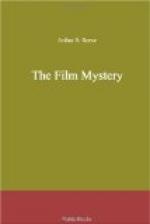Manton represented a secondary phase in film finance. Continent Films, his first corporation, was a stockjobbing concern. Grasping the immense popularity of Stella Lamar, he had coaxed her away from the old studio out in Flatbush where all her early successes had been photographed. With the magic of her name he sold thousands of shares of stock to a public already fed up on the stories of the fortunes to be made in moving pictures. When much of the money so raised had been dissipated, when Continent’s quotation on the curb sank to an infinitesimal fraction, then it developed that Stella’s contract was with Manton personally. Manton Pictures, Incorporated, was formed to exploit her. The stock of this company was not offered to outside investors.
Stella’s popularity had in no way suffered from the business methods of her manager. Manton, at the least, had displayed rare foresight in his estimation of public taste. Except for a few attempts with established stage favorites, photographed generally in screen versions of theatrical classics and backed by affiliations with the producers of the legitimate stage, Continent Films was the first concern to make the five-reel feature. Stella, as a Continent player, was the very first feature star. Under the banner of Manton Pictures, she had never surrendered her position of pre-eminence.
Also, scandal somehow had failed to touch her. Those initiated to the inner gossip of the film world, like myself, were under no illusions. The relations between Stella and Manton were an open secret. Yet the picture fans, in their blind worship, believed her to be as they saw her upon the screen. To them the wide and wistful innocence of her remarkably large eyes could not be anything but genuine. The artlessness of the soft curves of her mouth was proof to them of the reality of an ingenuous and very girlish personality.
Even her divorce had helped rather than harmed her. It seemed irony to me that she should have obtained the decree instead of her husband, and in New York, too, where the only grounds are unfaithfulness. The testimony in the case had been sealed so that no one knew whom she had named as corespondent. At the time, I wondered what pressure had been exerted upon Millard to prevent the filing of a cross suit. Surely he should have been able to substantiate the rumors of her association with Lloyd Manton.
Lawrence Millard, author and playwright and finally scenario writer, had been as much responsible for the success of his wife as Manton, and in a much less spectacular way. It was Millard who had written her first great Continent success, who had developed the peculiar type of story best suited for her, back in the early days of the one reel and General Film.
It is commonly known in picture circles that an actress who screens well, even if she is only a moderately good artist, can be made a star with one or two or three good stories and that, conversely, a star may be ruined by a succession of badly written or badly produced vehicles. Those of us not blinded by an idolatrous worship for the girl condemned her severely for throwing her husband aside at the height of her success. The public displayed their sympathy for her by a burst of renewed interest. The receipts at the box office whenever her films were shown probably delighted both Manton and Stella herself.




